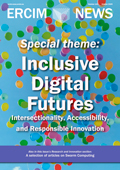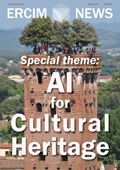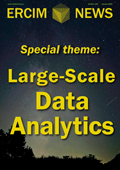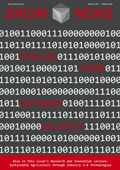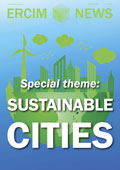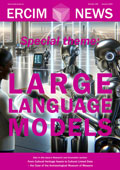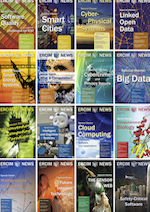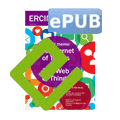ERCIM News No. 143 (January 2026)
DEADLINE FOR CONTRIBUTIONS: Tuesday 15 December 2025
Please read the guidelines below before submitting an article.
A Word template for ERCIM News articles is available for download.
The sections of ERCIM News 143 are :
- Joint ERCIM Actions
- Special Theme: AI for Science
- Research and Innovation
- Events
- In Brief
The Special Theme and the Research and Innovation sections contain articles presenting a panorama of European research activities. The Special Theme focuses on a sector that has been selected by the editors from a short list of currently "hot" topics whereas the Research and Innovation section contains articles describing scientific activities, research results, and technical transfer endeavours in any sector of Information and Communication Science and Technology (ICST), telecommunications or applied mathematics. Submissions to the Special Theme section are subjected to an external review process coordinated by invited guest editors whereas submissions to the Research and Innovation section are checked and approved by the ERCIM News editorial board.
Special Theme: AI for Science
Artificial Intelligence (AI) is rapidly transforming the way science is conducted. From accelerating the discovery of new materials to modeling complex climate systems and supporting biomedical research, AI has become an essential tool for advancing knowledge. By enabling more efficient data analysis, powerful simulations, and new forms of hypothesis generation, AI helps researchers tackle problems that were previously too complex or time-consuming to solve.
In line with the European vision of trustworthy, human-centred, and sustainable AI, This special theme explores the growing role of AI as a catalyst for scientific progress across disciplines. It aims to showcase innovative methods, interdisciplinary collaborations, and real-world applications where AI enhances scientific research and discovery. Contributions may highlight both fundamental advances in AI technologies and their application to pressing scientific challenges.
Relevant topics:
- AI methods for scientific discovery and innovation
- Machine learning for physical, environmental, and life sciences
- AI-driven modelling, simulation, and prediction
- Data-driven science and automated experimentation
- Large language models and generative AI for scientific writing and hypothesis generation
- Interdisciplinary research enabled by AI
- AI for climate and sustainability research
- AI for material science and energy
- AI for health, medicine, and drug discovery
- AI safety, and responsible and trustworthy AI in science
- Open science and AI-enabled scientific infrastructure
- Case studies of successful AI–science collaborations.
All articles have to be sent to the local editor for your country (see About ERCIM News) or to the central editor This email address is being protected from spambots. You need JavaScript enabled to view it.
Reviewing:
Articles submitted to the special theme and the research and society sections are subject to a review process.
Guidelines for ERCIM News articles
Style: ERCIM News is read by a large variety of people. Keeping this in mind the article should be descriptive (emphasize more the 'what' than the 'how') without too much technical detail together with an illustration, if possible.
Contributions in ERCIM News are normally presented without formulas. One can get a long way with careful phrasing, although it is not always wise to avoid formulas altogether. In cases where authors feel that the use of formulas is necessary to clarify matters, this should be done in a separate box (to be treated as an illustration). However, formulas and symbols scattered through the text must be avoided as much as possible.
Length: Keep the article short, i.e. 800 +/- 100 words.
Format: Submissions preferably in ASCII text or MS Word. Pictures/Illustrations must be submitted as separate files (not embedded in a MS Word file) in a resolution/quality suitable for printing.
Structure of the article:
The emphasis in ERCIM News is on 'NEWS'. This should be reflected in both title and lead ('teaser').
Also: NO REVIEW ARTICLES!
- Title
- Author (full name, max. two or three authors)
- Teaser:
a few words about the project/topic. Printed in boldface, this part is intended to raise interest (keep it short).
- Details describing:
what the project/product is
which institutions are involved
where it takes place
why the research is being done
when it was started/completed the aim of the project
the techniques employed
the orientation of the project
future activities
other institutes involved in this project
co-operation with other ERCIM members in this field
- References:
- 1 - max. 3 references are mandatory for special theme articles. For articles for the section "Research and Development", you can give up to three references (not mandatory)
- Authors should preferably refer to important sources only (i.e. journal papers, books) and avoid meaningless references such as article in preparation, unpublished presentations, personal communications, research reports, patents, or local conference publications not listed in the major scientific digital libraries (such as IEEE, ACM, Springer).
- The selected EN style is the shortened IEEE Citation Style.
- The references should be as concise as possible and restricted to the minimal information needed. Avoid all unnecessary words (pages x pp., year, editors, location,...). Use acronyms instead of full conference names - OOPSLA x Object-Oriented Programming Systems, abbreviations (e.g. Conf. x Conference, IEEE TPAMI x IEEE Transaction on Pattern Analysis and Machine Intelligence, etc.).
- Use et al. when three or more names are given.
- Useful Link(s) (URLs separated from the references)
- Contact address with:
- full name of the author
- phone number
- Photos, illustrations:
ERCIM News is a full-color print magazine. Each article should be accompanied by an illustration (photos, graphics), for example of the product, applications mentioned in the article, people working on the project, etc. (avoid as much as possible flow charts and screen dumps).
Photos should be submitted in jpg or tiff format in a resolution suitable for printing (pictures taken from the web are usually in a quality suitable for printing), graphics in a vector format (svg, eps, pdf).
A Word template for ERCIM News articles is available for download.
Publishing in ERCIM News offers several advantages:
- ERCIM News represents an excellent opportunity to present your research to a broad audience, also outside your own research community
- ERCIM News is published in print and online and reaches about 10,000 readers
- ERCIM News is widely distributed in the European Commission
- ERCIM offers a free professional proof-reading service
- Authors can reuse their articles; the copyright of the articles remains with the authors.
- Articles of the sections "Special Theme" and "Research and Innovation" are referenced by DBLP and by Web of Science (from issue 104 onwards)

